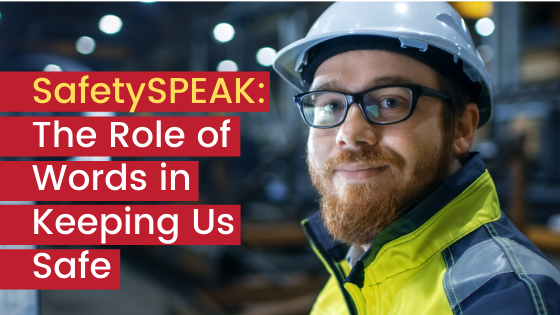
Keeping safety front of mind is vital within all environments to stay safe, and it’s through process and culture where we can influence our safety performance and results. To achieve the pinnacle of safety culture and performance, it requires safety to start within – within every one of us both at home and at work – which requires us all to take responsibility for our own and for others safety.
To help create our best ‘SafetySELF,’ we can choose not only our mindsets so that we operate with our SafetyMIND but also our feelings so that we are conscious of our SafetySTATE.
What we also need to bring conscious and consistent attention to is our SafetySPEAK.
The different angles that exist within SafetySPEAK are:
1.What You’re Saying to Yourself
Your self-talk determines what you feel, think and focus on. If your self-talk is negative, disruptive, distracting or even combative, it won’t serve you. It will move your focus away from what you want within your performance to a focus that is on what you cannot control.
The consequence of feeling a lack of control is that you won’t be as safe.
More than ever, amongst all the uncertainty we are living with at the moment, we need to reinforce the feeling of control we have over our life, and you can do this just by checking in on your self-talk and switching the language to something more positive and where you can own the results of your day in whatever context – be it safety, productivity and leadership.
Taking it one step further, by verbalising your wishes and goals, you also start activating your Reticular Activating System – that is, your unconscious scanner in your brain that will start to look for matches or opportunities to make what you want happen, happen.
Don’t believe everything you tell yourself – you can change it up and make it far more productive. It just takes practise to make it a habit for it to become second nature. Positive self-talk can literally change your reality.

2.What You’re Saying to Others
“Spoon feeding, in the long run, teaches us nothing but the shape of the spoon.” E.M.Forster
When people have the perception that they have control over their input and their role, they work better and safer.
When you trust them to work while holding themselves up to consistent high standards, they will step up and switch on. As demonstrated by this COVID enforced remote working spell, I’d imagine that the majority of your workforce has proven that it can work just as successfully as working from the workplace.
We can create teams that work safer by using language that empowers them and transfers ownership of the work to them. To do this, collaborating rather than dictating is essential. Hand over the control factor to them and watch their performance improve.
Think about the words you use and how you say them. Convoluted and complicated messaging doesn’t work for our unconscious minds – we need simplicity, clarity and repetition for a message to really stick. Help their focus sharpen by carefully choosing the best words for the job.
3.What Others are Saying to You
One of the most challenging things to do if you want to influence someone is to switch off your mind-reading function. That is, stop assuming. Stop assuming what they’re thinking, feeling, or even saying. Listen beyond the words they’re using and you will be able to get a more accurate version of their reality.
Question what it is they understand or know. As adults, we don’t always offer up admissions of a lack of understanding or knowledge – which can lead to serious misunderstandings and even safety incidents.
As a rule of thumb, keep questioning until you’re really satisfied that what they are saying to you is their version of reality, not yours.
Interested in learning more? Contact Deborah on 0420 204 982 or email deborah@deborahkeep.com for more information on her SafetySELF initiative, the Foundation of her Safety Culture Program.

Hi Deborah, thank you for sharing your thoughts on the importance of words/language, with safety awareness and preventing incidents. Linkage words are also important.
Additionally, I believe all Safety Culture change actions are how we do business, not “programs”.